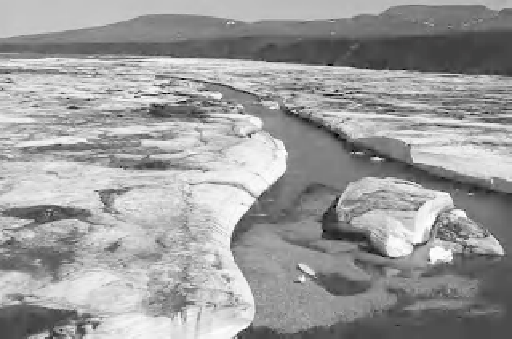Geology Reference
In-Depth Information
Figure 5.11.
The Babbage River icing, Barn Mountains, northern Yukon, Canada, is associated
with perennial discharges through Triassic-age sandstone and limestone. The icing was ablating and
about 3-4 m thick at the time the photo was taken in mid-July 1979.
temperature in the spring (van Everdingen, 1982, 1990). During the early summer months,
icings usually melt completely. Sometimes, the thickness of the icing can be inferred from
scars on the barks of trees adjacent to the icing location. Others, such as that which forms
on the Babbage River, northern Yukon, Canada (Figure 5.11), are favorite gathering
places for caribou to escape heat and mosquitoes in the summer.
Groundwater icings associated with perennial springs may assume considerable dimen-
sions. In central Yakutia, four large icings associated with perennial springs are located
in tributary valleys of the Lena River. In the Ulakhan-Taryn spring, the average maximum
icing accretion volume exceeds 200 000 m
3
(Anisimova et al., 1973, p. 42). In the Mom-
skaya Depression of northeast Yakutia, complex icings as large as 62 km
2
are known to
occur (Nekrasov and Gordeyev, 1973, pp. 37-40). In Alaska, an icing over 10 m thick and
more than 1 km wide and 2 km long formed in the St John River valley in 1969 (Ferrians
et al., 1969, p. 346).
5.7. PERMAFROST AND TERRAIN CONDITIONS
Although the broad controls over permafrost distribution are climatic in nature, local
variations in permafrost conditions are determined by a number of terrain and other
factors (Kudryavtsev, 1965; Brown, 1973a, b). Of widespread importance are the effects
of relief and aspect, and the physical properties of soil and rock. More complex are controls
exerted by vegetation, snow cover, water bodies, drainage, and fi re. Generally speaking,
the most complex permafrost-terrain relationships occur in discontinuous permafrost.
In the following discussion emphasis will be placed upon the latitudinal permafrost of
North America and Eurasia.
5.7.1. Relief and Aspect
Relief infl uences the amount of solar radiation received by the ground surface and the
accumulation of snow. Slope orientation also infl uences the amount of solar radiation

